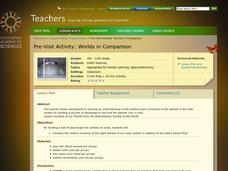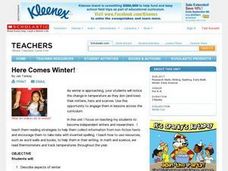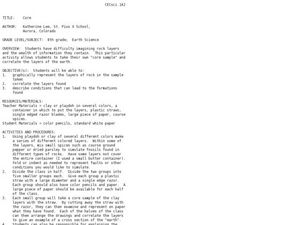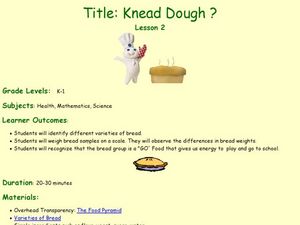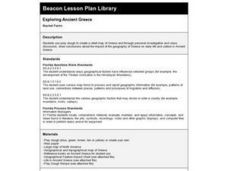Pacific Science Center
Worlds in Comparison
Young astronomers follow a step-by-step procedure for dividing a lump of dough into parts, resulting in a scaled volume set of puny planets. Along with the printable directions is a template chart of planet names on which learners can...
Channel Islands Film
Arlington Springs Man: Lesson Plan 3
Imagine being part of a team of scientists that discover the oldest human remains in North America. Imagine being part of the crew that documents this discovery. Class members get a change to be part of such an exciting adventure in a...
Curated OER
The Island of the Skog
"Students read "The Island of the Skog." Prior to reading, students observe the book cover, predict the events of the story, and discuss what a skog may look like. Students make footprints in play dough and observe the differences...
Curated OER
Minerals Make Rocks
Students examine that all rocks are made from one or more minerals (or plant material, as in the case of coal). They make mock rocks and discuss the difference between a rock and a mineral.
Curated OER
Making Bouncing Balls
Students investigate the movement of balls and use different materials to make balls. In this bouncing balls lesson, students explore the movement of balls, they investigate the inside of balls and they design and make their own balls...
Curated OER
Dino-Friends
Students learn about dinosaurs. In this dinosaur lesson, students participate in an interactive read aloud of The Giant Book of Dinosaurs. They make play dough dinosaurs and write a dinosaur story about their sculpture. They dance around...
Curated OER
Investigating Shapes in Our World
First graders explore shapes. For this geometry lesson, 1st graders make shapes with geo-boards, use play-dough to make three-dimensional figures, and make a shape book using pre-cut shapes.
Curated OER
Here Comes Winter!
Students investigate winter behaviors in animals. They describe winter and write about the characteristics of the season by drawing and labeling a winter picture. Students then conduct research on a chosen animal and create a chart. ...
Curated OER
Core
Eighth graders take their own "core sample" with clay and/or play-dough and correlate the layers of the earth.
Curated OER
Making a Thermometer
Young scholars observe a demonstration of how a thermometer functions. They apply the scientific method while determining which of three cups hold the coldest water. They write a hypothesis before conducting the experiment and gather data.
Curated OER
Knead Dough?
Students make bread and understand that bread gives us energy. For this bread lesson plan, students read the story A Trip to the Market, and learn about the importance of bread. Then they make the bread!
Curated OER
A Hidden Beauty
Expose the beautiful mystery of bulbs as young botanists learn all about these fascinating plants. They glean information from a short text before observing actual bulbs (consider an onion), and comparing their findings with predictions....
Curated OER
Making Prehistory
Students create mock fossil records based on current scientific theories about prehistory. By learning about what fossil records teach us about different prehistoric time periods, students gain a greater understanding of theories of...
Curated OER
Exploring Ancient Greece
Sixth graders use play dough to create a relief map of Greece and through personal investigation and class discussion, draw conclusions about the impact of the geography of Greece on daily life and culture in Ancient Greece.
Curated OER
Chopping Cubes
Middle schoolers work in small groups to make various geometric solids with Play-Doh. They use fishing line to make cuts and observe the shapes of the cross-sections. Pupils complete an assessment in which they answer questions such as:...
Curated OER
Language Arts: Scavenger Word Hunt
Participate in a scavenger hunt to find objects beginning with a particular letter sound and take digital photos of them with your scholars. Using software, they find word pictures beginning with particular letters and locate picture...
Curated OER
Scale/Ratio
Investigate the use of ratios in scale drawings. Learners scale objects up or down using ratios then find the actual size of something using ratios. They apply their knowledge of ratios as they make their own telescopes in science...
Curated OER
Sand and Water
Students follow this recipe for fun clay creations. In this early childhood art and science activity, students develop creative-thinking skills, fine-motor skills, and sensory awareness while they make, mold, and decorate salt dough.
Curated OER
Cell Reviews
High schoolers draw cells, make a cell, and list organelles in plant and animal cells. In this cells lesson plan, students create edible cells.
Curated OER
Worms And More
Young scholars complete five center activities that in order to determine the attributes of length and area. They study the vocabulary associated with measurement of length and area. They use blocks, play dough, wrapping paper, and...
Curated OER
Yellow Pod
Students use appropriate skills to design and conduct scientific investigation. They sort and classify various ingredients and analyze their investigation. Finally, students describe the observable states of matter, bot solids and liquids.
Curated OER
Cookie Fun
Students make cookies to celebrate the May Day holiday. They discuss the significance of May Day, listen to the book "If You Give a Mouse a Cookie" by Laura Numeroff, and decorate cookies with spring colors. Students also create a card...
Curated OER
What Shape is That?
Each country or group of people has created special places of worship. Children read a story about religious buildings and architecture and then make clay models of the buildings they like the best. The lesson has been written to...
Curated OER
Malta: The Landscape
Students work in small groups to create a topographic map of Malta. They must include labeled line drawings of bordering countries and bodies of water. Students use salt and flour clay to make Malta three dimensional, showing the nearest...


